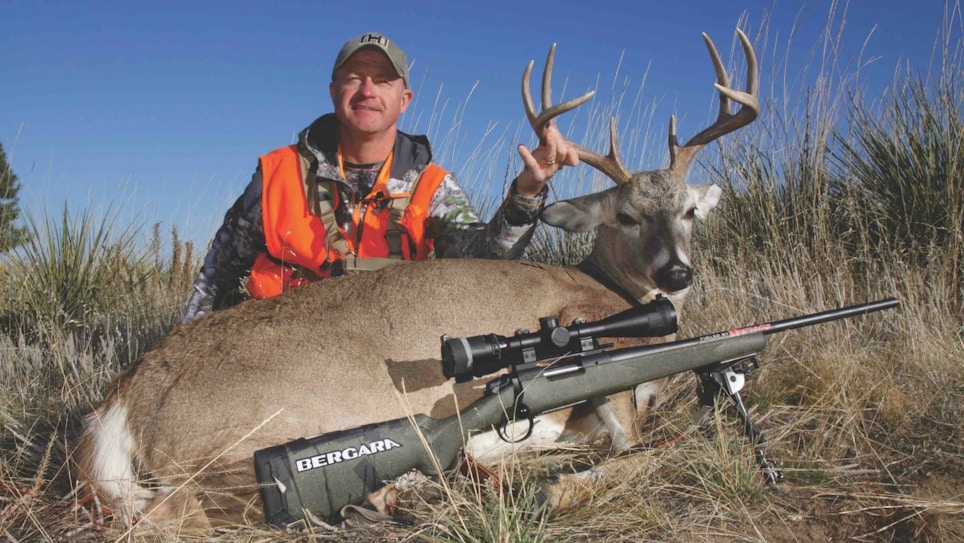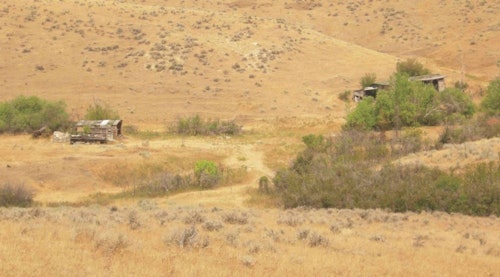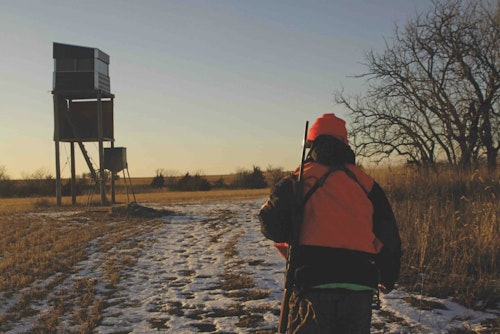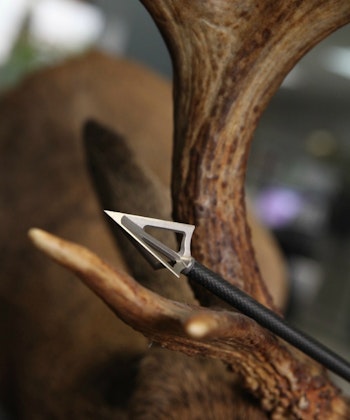
The author returned for several consecutive sits to a known hotspot, waiting for this buck to return after a couple of days of rutting.
Whitetail hunters often refer to the rut as “awesome,” with dreams of monster bucks suddenly acting like reckless adolescents during the interlude. It happens, but oftentimes the rut drives your anxiety level a different direction due to the disappearance of your primary target. Ughhh!
There’s no right or wrong game plays during the rut, unless you have access to the GPS tracking collar of your No. 1 buck on the hit list. I’ll reveal some of that GPS insight further into the article, but for you it’s typically a guessing game utilizing trail camera captures, real-world observations and most of all, gut instinct.
Traditional-living whitetails rut in a predetermined fashion as you likely know. During pre-rut, the weeks leading up to actual breeding, most bucks stay near home. Your trail cams will confirm this homebound behavior along with the increasing number of rubs and scrapes along edges and trails. As does begin the estrus cycle, all patterns start to unravel like that fishing reel you spooled as a kid. Bucks that were once creatures of consistency are now as unreliable as 5-year-old deer urine is an attractant.
And if that wasn’t enough to worry about, there are a whole host of variables that could make your top antler priority a no-show for the remainder of the rut. So what’s your plan? Once you consider the variables affecting the repeat appearance of your star buck, you can either stick with old, reliable locations or pioneer into uncharted hideouts to find the buck of your dreams. As you ponder a plan, be sure to include these variables that could alter your mission.
Variables to Consider
As you contemplate a strategy for the rut, don’t forget all of the “what ifs.” These unpredictable considerations are the reason you may need to change up your hunting location or re-edit your hit list. First, consider the fact that your buck may be on its way to the taxidermist via a neighbor’s Lyft service. Just because you have a locked gate on your hunting property doesn’t mean your buck will stay on your side of the fence. Hunting pressure on neighboring properties is a distinct possibility in this day and age of seeing treestands on every 20-acre parcel.
How far does the average buck roam during the rut? That depends on a host of moving parts including deer density, land management practices, hunting pressure and the personality of individual bucks. One of the most intriguing and recent studies of a rutting buck was compiled through GPS tracking data from a Penn State Department of Agricultural Sciences study over the course of nearly 2 years. This study took place in the Bald Eagle State Forest located in central Pennsylvania. This buck was subject to public hunting pressure and did not live a guarded existence on a manicured hunting property.
For most of the year the buck, dubbed 8917, followed a routine whitetail lifestyle of living in a 1-square-mile homeland. Occasionally he would venture farther, but “homeboy” describes him like most whitetails. On November 5, 8917 decided it was time to stretch his legs. His journeys took him farther and farther from home base, including one huge marathon on November 13. He traveled nearly nonstop (as he did most of the rut) and racked up more than 5 miles of travel with more than a mile of elevation change. If that buck lived in a woodlot in Illinois, it would have undoubtedly dodged several arrows or slugs with such a wandering lifestyle.
To put a wrap on 8917: He traveled approximately 23 miles most of October, but for nearly the entire month of November this Forrest Gump wannabe tallied an impressive 85 miles. In addition to the possibility of running across does to breed, a buck may also venture into an active shooting lane. Keep that in mind as the rut unfolds.
Knowing whether your A-lister buck is dead may be a mystery that haunts you to the grave … or not? With the dependence on social media, it’s common for you to discover your No. 1 may already be on the way to a taxidermist. One of my hunting friends monitors social media in his zip code like the CIA monitors terrorist communications. Two to three times a season he sends me depressing texts with a trail cam pic of a buck he’s been watching attached to a hunter image smiling over the same buck. It’s medication-level depression for him, but he also knows when to stop hunting for one buck and begin looking for another.
By keeping open communications with your neighbors you may also get notification of a buck’s demise. Another of my friends manages approximately 120 acres in Wisconsin. His outreach to help adjacent deed holders with wildlife property improvements guarantees they share with him when a buck walks across the fence and takes a trip to the meat processer. It also improves management as everyone is now on the same page and lets young bucks walk to mature into Wisconsin monsters as conditions warrant.
In addition to hunting pressure, you have to be aware that deer die just from the same things you might encounter. Predation, vehicle collisions, disease and bizarre accidents can claim deer on any day. Penn State deer 8917 had a gravel road halving its home territory, but avoided being hit. Researchers noted though that the first doe they captured lived in a similar setting, but was struck by a vehicle bluntly ending that GPS analysis.
Although GPS data and your personal insight tells you almost nothing about where to expect your top contender to show up during the rut, it does give you options as you map out the month of November. Your two basic choices are to stick with old, proven hotspots or pioneer your way to uncharted waters.
Think Old Reliable After a Dry Spell
Frustration can kick in just days prior to estrus and throughout the breeding window. Why? Bucks abandon all sense of a pattern. That Halloween happiness of seeing your buck nightly on a trail camera and knowing you’re just days away from a daytime meeting evaporates with the first whiff of doe-in-heat.
It’s easy to appease yourself with a move to a new stand. New sights, new deer and the possibility your buck will wander to the far side of a farm keeps you motivated. There’s nothing wrong with the proverbial jumping ship, but keep in mind one important aspect: Whitetails are true to the core about home. Arnold Schwarzenegger said it best. “I’ll be back.” Unless your whitetail buck is on its way to its creator, the odds are high it will return home.
Various research studies, including the inside look into Pennsylvania buck 8917, reveal most bucks venture home between all-nighters. Although you may never know what GPS direction a buck takes each day, number 8917 does show a keenness to return to home throughout his November adventures. Sometimes 8917 passed right through home, and during other times he skimmed the perimeter. Nevertheless, he never forgot his roots until another life-changing event kicked off: rifle season. That occurred in Pennsylvania at the end of the rut. The army of orange spurred buck 8917 to abandon his homeland for a refuge-ripe ridge and he went into lockdown mode, but that’s another bedtime story.
For now, keep in mind that your buck will return home. Travel during the rut continues nonstop. Bucks venture one direction or another, oftentimes driven by wind direction and doe activity, but by keeping a constant vigilance your odds for success are not necessarily diminished. What you may have to deal with though is changing your target buck.
Unless you live a Drury lifestyle that allows you uninterrupted days afield, you may have to settle for whatever buck shows up on allowable days in the field. That’s not all bad if you hunt in an area branded for bruiser bucks, but it could pose a problem if you only have one buck objective in a sea of adolescent prospects.
Last season I was smitten with a buck my buddy dubbed “Heavy Duty.” I called him “HD” for short. HD started out as a regular visitor to a ridgetop food plot, albeit with a nocturnal nature captured by trail cameras. Nevertheless, I opted to stay vigilant on the ridgetop food plot waiting for him to slip up in daylight. His sudden absence from trail cameras the first days of November sent me into a panic attack, and I immediately began hopscotching between stands on this farm to relocate Romeo.
In brief, I decided to return to the beginning believing HD would return home. Altogether I tallied 8 days on stand before HD returned to the same food plot he was patterned to during the pre-rut. I ended my whitetail bow season with one of my best bucks to date simply by abandoning a nomadic hunting style and going back to the dugouts. I embraced the old, reliable stand and it paid off big time.
Turn a New Frontier Into Old Reliable
Never say never. You may need to strike out to a new hunting location. Hopefully you have a backup network of stands in place, but like the hideout preferences of pressured bucks, that’s another topic for another article. Nonetheless, you may need to look for new frontiers if your hotspot becomes a cool location or a buck disappears from radar. Where do you look?
For a lockdown buck, you will want to look for the most ambiguous place you might consider. To help you visualize this locale, think of it as a setting you’re least likely to hunt. Can you picture that setting? Hunting apps such as HuntStand help you decipher hideouts from above and then give you the tools to hunt an offbeat locale effectively.
While hunting Western whitetails, it’s common for river-bottom bucks to leave the sanctuary of riparian cover with an estrus doe and honeymoon in adjoining sagebrush openness. I’ve hunted several lovebird pairs in these backdrops relying on pronghorn hunting strategies over treestands.

Of course Midwest whitetails don’t have the luxury of sagebrush, but never overlook a cattle pasture, cut cornfield or even a plowed field left for fallow. Last fall I watched a decent-size buck court a doe across a grazed cattle pasture. The pair bedded between pursuits, and the buck would lay his chin on the ground to help blend into the background.
An Illinois hunting crony of mine recapped a hunt where he once watched a buck and doe jump into the pen of an overgrown, and unused hog shed. My friend waited until he could be sure of their intended napping objective, then snuck in for a shot. It almost worked had he not stepped on a rusty nail that created an unexpected commotion that sent the whitetail pair fleeing.
Abandoned farmsteads, weedy lots, out-of-the-way hollows and even antiquated farm equipment provide overlooked cover for breeding whitetails. They’re looking to dodge the pressures of other, pestering bucks, but also you as they duck into unconventional cover.
Two years I hunted a hotspot in Kansas with optimism a mature buck would show. Lady luck never shined on me the first half of the hunt, so I rolled the dice and moved to an obscure stand adjacent to an isolated wetland. Ducks were more common than deer, but occasionally a buck would prod a doe into the cattail edges for seductive seclusion. Two days into my watch, a buck sporting above-average mass cruised through to see if any single gals were renting nearby. I made a good shot with my Montec broadhead and he tumbled before escaping the love nest.
You’ll never be able to read a buck’s wandering mind during the fog of the rut. Face that reality. He makes decisions like you did when you were 16. Even so, stick to your original plan. When that doesn’t pan out, it may be time to vacate an old, reliable set for the new frontier.
“Awesome” eloquently describes the whitetail rut, but be prepared. Your leading actor could skip out on the stage you set for some back-alley playhouse. He’ll be back, but the wait could cause you a panic attack as you wait for the awesomeness of the rut to regale you.
Sidebar: Good Gear to Boost Your Rut Confidence
Being a multi-season hunter provides countless advantages when it comes to filling a freezer with prime whitetail venison. My season kicks off September 1 with archery gear and concludes sometime in late December. Archery hunts tend to be my most punishing endeavors, thus the reason to spend wisely on topnotch gear. A leader in the archery market, Prime offers their Logic CT series of bows to meet the demands of long seasons. Each model caters to the specific shooting characteristics you may be searching for in a hunting bow with length options ranging from 31 axle-to-axle inches to 39 inches. Brace heights from 6 to 7 inches also allow for you to find a compatible partner whether on the ground or in a tree. IBO ratings of up to 335 also guarantee flat-line travel for your arrow launch.
One of the most unique aspects of the Logic CT series is your ability to mix and match camouflage, and colors on the limbs and riser. You can choose from popular camouflage schemes or colors for each giving you unmatched selections to tailor a look for your hunting environment.
The G5 Prime family includes another big game favorite, the G5 Montec broadhead (below). It’s the one recommendation you hear time and time again from seasoned outfitters that understand the demands of a broadhead. For 2019 you can choose from stainless-steel and carbon-steel models with the stainless steel offered in 85-, 100- and 125-grain models. The Montec Carbon Steel is available in 100-grain only.
For the 2019 season, I have teamed up with the Logic CT3, a 33-inch axle-to-axle powerhouse that weighs in at 4.5 pounds. It’s light enough for any mountain bowhunt, but has just the right amount of weight to balance perfectly for a long shot on a food plot edge. And if my Prime bow and G5 Montec don’t get the job done, I’ll rack a red-tipped bullet to hopefully end the season with backstraps just in time for Christmas.







